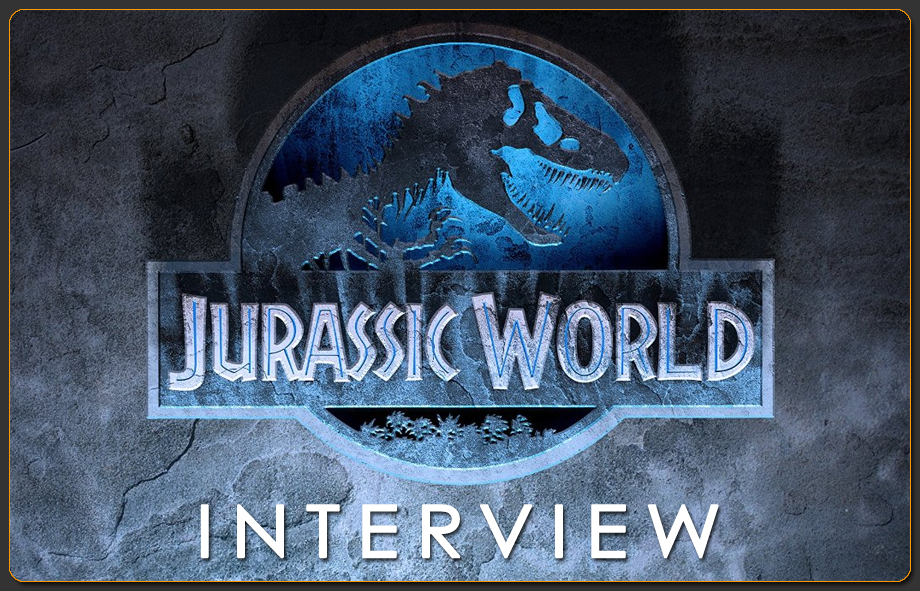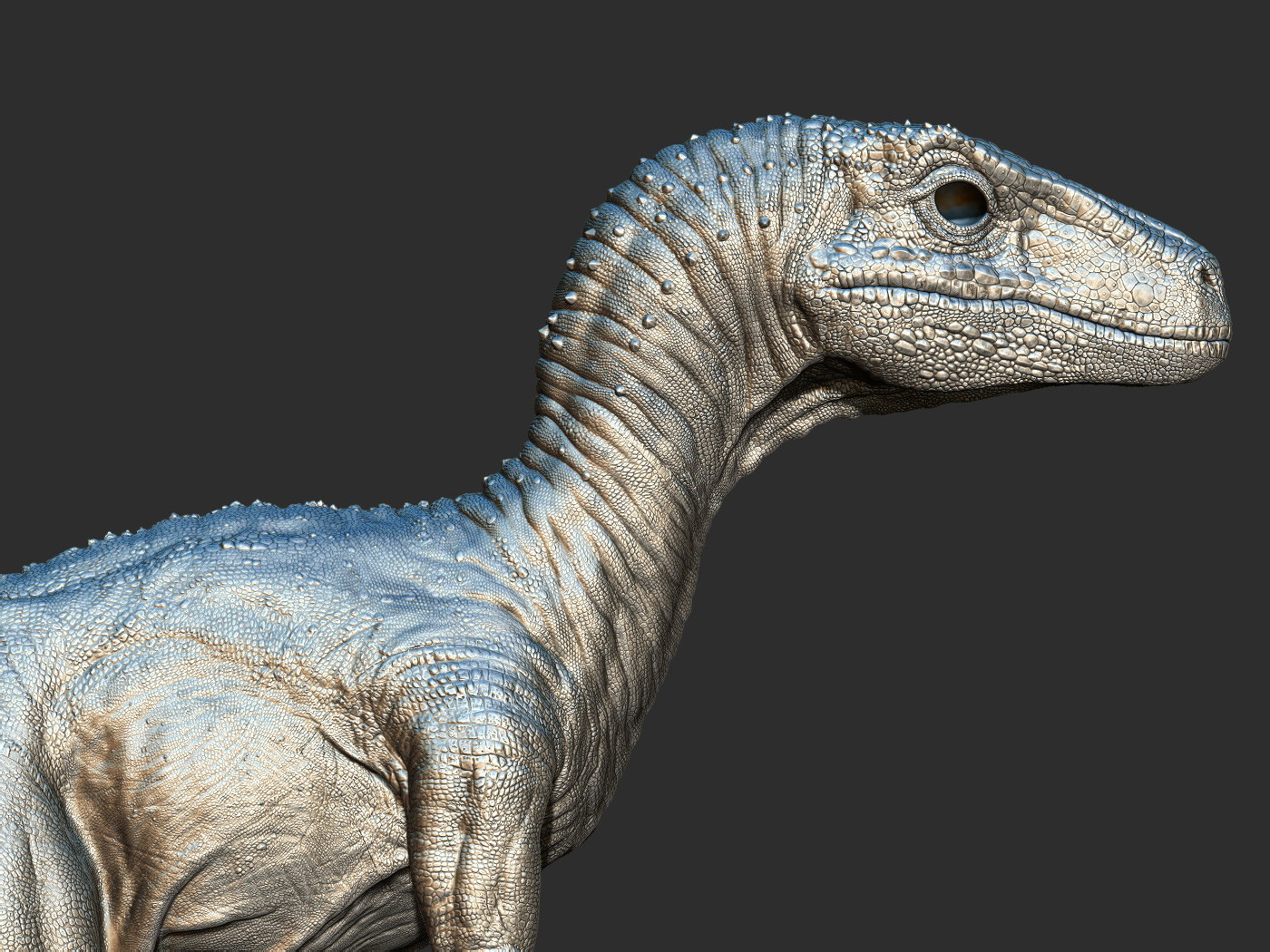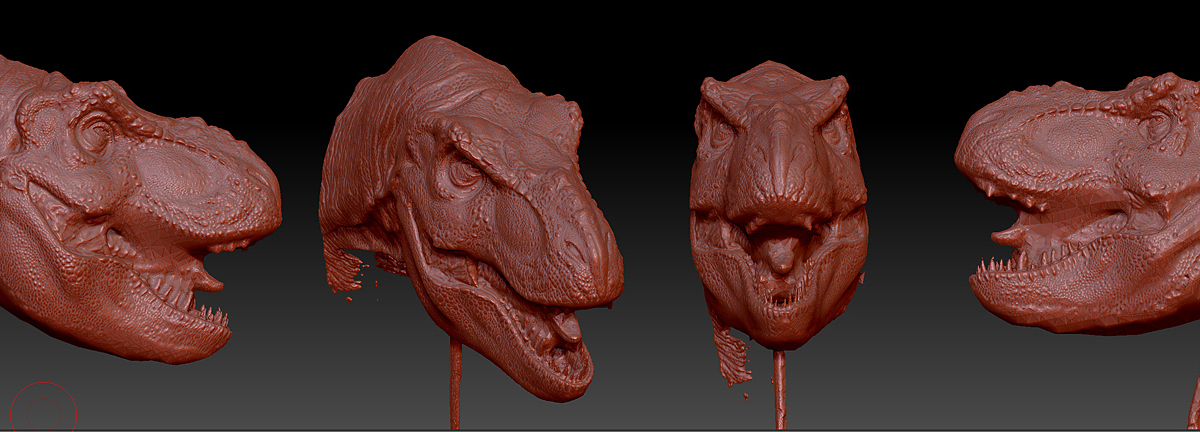
Yet technology has advanced in the intervening years. So when ILM started work on Jurassic World, the ILM team had an interesting challenge: How to tap into modern digital effects capabilities while remaining true to the style of the original masterpiece?
Today, we are pleased to bring you an interview with Digital Creature Model Supervisor for Jurassic World, Geoff Campbell. He talks about just these issues and how ZBrush was a key piece in the puzzle. (You’ll also spot several artist names that are well known in ZBrushCentral circles!) We hope that you enjoy this chat with the artists that brought to life the most successful film in the Jurassic Park franchise to date – a movie that enjoyed a record-breaking opening weekend, was the second highest-grossing film of 2015 and the 4th highest of all time!
Jurassic World was a departure from the previous films in that effects went from practical to digital. Could you talk about that and the challenges involved? Did you put any kind of effort into trying to maintain the feel of dinosaurs from previous installments of the franchise?
Most of T-rex shots in the original Jurassic Park were digital models although there were the Stan Winston practical models for a number of closeup shots. But even starting from the original ILM digital model posed a number of challenges.
The first was maintaining the look and feel of the original T-rex while aging her 23 years. We didn’t have access to the original molds or castings which were all in LA but we did have a four foot original casting that had been made for us back in 1992 and which sits on display in our San Francisco studio. I made a suggestion that we scan that model as a starting point for recreating the Winston mode. Steve Jubinville, Martin Murphy and Landis Fields grabbed an old Next Engine scanner and tripod and along with Greg Grusby, the head of ILM publicity we pried open the Plexiglas case and started scanning that model. This provided Steve with a great template for the new model. However, I had a few reservations about this original maquette we were scanning because on the original Jurassic Park, Steven Spielberg had made several changes with Steve Williams, the ILM artist who built the original digital T-rex. Those changes differed from the Winston maquette. The arms were a different length and the feet on the digital version were larger and stockier. Also, the head of the digital model had the jaw more streamlined as well as some adjustments to the angle of the eyes. So for the T-rex in Jurassic World we wanted to find the balance between the on screen T-rex from Jurassic Park and the Winston model.
To access the original ILM T-rex data we went back to the ILM archives which houses historical data, hardware and software, and retrieved the model. Once getting it back online we began the process of converting the model from b-spline patches to polygons and then brought that model alongside the scanned Winston maquette so that Tim Alexander (the film’s Visual Effects Supervisor) and Glen Macintosh (the ILM Animation Supervisor) could present them to Colin Trevorrow. From there Steve made the sculptural changes and alterations to create a T-rex that was somewhere in between the digital original and the practical model. As it turns out, that was just the beginning.
We now had our version to match the original Jurassic Park T-rex but we needed to age her 23 years to bring her into the present day. Tim and Glen suggested that we take into account that she’d been incarcerated in a theme park for all those years and her muscles would have atrophied somewhat. We also considered that she would be showing signs of stress, but most of all she needed to remain recognizable as the heroic, statuesque T-rex from the original movie. I think the most surprising reference we received was from Colin, who sent us shirtless images of an aging Iggy Pop wearing a pair of faded cut off blue jeans. What was interesting in that reference was the sinewy, veiny nature of his skin since he had practically zero body fat. Steve used that as his guide and did an excellent job aging T-rex while keeping her muscular and easily identifiable as the T-rex we all know and love. ILM’s Erik Halsey, who is also an expert ZBrush artist did the beautiful texture work on the T-rex.
The raptor models underwent a similar approach because we didn’t have access to the original practical casts. We did have a full scale foam raptor sent up from LA that was part of a theme park ride, but it wasn’t in great condition and it didn’t look as interesting as a small two foot maquette we had on display on a pedestrian bridge between two of our San Francisco ILM buildings. I had run past that maquette on my way to countless meetings for the previous ten years and when I stopped to take a good look at it, I felt it had much more of the character we were looking for in the raptors. We scanned the maquette and used it as the starting point for Blue. Once we had topology in place we took it into ZBrush for extensive sculpting refinements. For texturing, Ting Lo did a beautiful job of ZBrushing intricate scale detail over the entire body.
With all our dinosaurs and especially with the Indominus Rex, or the D-rex as it was known within ILM, the biggest difference between the Jurassic Park models and the Jurassic World models was the amount of detailed displacement done in ZBrush. On Jurassic Park all the displacement was 2D painted displacement but with Jurassic World it was sculpted in ZBrush and then Martin Murphy (our Paint and Texture Supervisor) would write out maps for the textures and could render out cavity maps, dirt maps, etc. for use in Mari. Steve and Martin also created saliva and crud geometry and textures that were rigged to stretch and shake when simulated along with tiny spit bubble geometry for those really tight close ups.
How did you go about conceptualizing and ultimately realizing the movie’s various dinosaurs, given that all we really have of what they looked like are skeletons? Were there any cases where you deliberately departed from science for cinematic reasons?
I think it’s a fine line but in the entertainment world artistic license always trumps science. We also had an easy out because Jurassic World is about scientists messing with DNA so any criticism of our dinosaur models could easily be justified by crazy DNA! Probably the biggest liberties were taken with the scale of the dinosaurs. That happened to us on the original Jurassic Park too when Spielberg saw our Brachiosaur model lumbering up the hill and said “make it bigger!” That’s actually a funny sequence to watch because in the last shot the brachiosaur is meant to stand on her hind legs and crane her long neck up to reach the leafy treetops. We scaled her up to almost twice her size and when she stood on her hind legs she towered over the branches so the animator had to lower her head and neck in order to reach the branches below her, which defeated the need to stand on her hind legs in the first place. But, I digress.
On Jurassic World, I don’t remember the original length of our Mosasaurus but we did get into similar territory by scaling her up larger than any known fossils to look bigger on screen for her death match with Indominus Rex. That’s where you need artistic license because that final scene wouldn’t work if a tiny Mosasaurus flittered out of the water and bit Indominus on the cheek.
In other cases we didn’t always know the science to begin with but were going from concept art and trying to make a model that felt believable. I think this is the case with the baby Indominus hatching from the egg at the start of the movie. One of our modelers, Matt Corcoran, took Steve’s full sized D-rex model and re-sculpted her into a disarming looking baby-D-rex. This was meant to be a quick one off shot so it was important to have the baby rex look menacing and not cute. The artwork showed tiny sharp teeth and a pulled up sneering lip which Matt did a great job of capturing in the model with a couple of strategic blend shapes for the animator.
Paul Liaw and Vaughn Smith both worked extensively with references they gathered from the Internet of the latest fossils for scientific accuracy. Vaughn modeled the Triceratops based on an earlier maquette created by Gio Nakpil and then modeled the baby Triceratops, sculpting in ZBrush from photos of rhinoceroses and elephants to replicate their leathery hides. Paul, who sculpted the Mosasaurus was very resourceful when it came to reference, which really made a difference with how beautifully the model came out. He did a great job carefully working from artwork and fossil reference but then working out the more subtle forms like the fins, the underbelly and her rigid back by referencing turtles, crocodiles, whales and a number of other animals he found online. He then fluidly incorporated these elements into the overall character, again sculpting in ZBrush, which was no small feat considering the huge scale of the Mosasaur. Final texturing and painting was done by ILM veteran Melanie Wallis.
[youtubehd]tOYTkeqv4RY[/youtubehd]
What were the challenges involved in creating Indominus rex, since it was a made-up dinosaur?
The challenge was to introduce a character that displayed a frightening, indiscriminate malevolence to anything that moves. With Blue and the other raptors there was always a slight hope you might be able to reason with her intelligence the moment before she rips through your intestinal track. And with T-rex, she may be unapproachable but there’s a majestic muscular quality and a history there that audiences from Jurassic Park can relate to. She’s like a prizefighter who’s earned her place in history to not be easily trifled with. But with Indominus there’s no soul, only an uncontrollable monster with a vengeance. ILM’s Kris Costa sculpted the original maquette from artwork created at Legacy Effects and that served as a template or starting point for the model. Glen McIntosh made a number of descriptive illustrations and sketches to bring out the armored plating along her neck and back, as well as defining her trade mark fenestrae between the nostrils and eyes and in front of the ear holes. If you include the eye cavity you get a kind of cathedral effect of three strong vertical structures defining her face.
One of the first things we noticed in comparing Indominus with our previous Jurassic Park dinosaurs was that she had monocular vision like the raptors, with great peripheral vision but lacking the focused binocular vision of a predator like T-rex. Regardless of the scientific data and whether or not T-rex even had binocular vision, Spielberg designed the original T-rex with her front facing eyes partly because she looked better when she was moving toward the camera. Colin Trevorrow wanted to follow that same plan of attack. Colin also liked the opposing tension of gnashing teeth that you find with crocodiles so we incorporated that into the design and then added more meat to her jaw for bone crushing. We also pulled her lower mouth forward to give her a menacing under bite. This was all in the very early design stage of defining the character as a maquette for basic approval from Colin.
The heavy lifting began with Steve Jubinville coming on board as the lead modeler for the show. Steve came with an incredible sculpting talent in addition to having worked on a number of dinosaur projects before coming to ILM. Building up his own reference library of lizards, birds and other animals he started sculpting an entirely new model of Indominus based on Kris’ maquette, starting with an accurate skeleton and muscle model for rigging and then moving on to the surface topology, detailing and adding structure, weighting skin folds, adding creases and aging along with bony scuta along the side of the head, neck and back. Martin worked with Steve, mapping out a scale pattern and the two of them worked back and forth in ZBrush, Adobe Photoshop and The Foundry’s Mari to finish the model and texture.
[youtubehd]1AYTySxjZ5E[/youtubehd]
What made ZBrush an essential tool for the production?
ZBrush was an essential production tool in so many ways. On Jurassic World it gave artists all the sculpting tools necessary for roughing out our dinosaur proportions for the larger forms and then work that model right down to the finest details.
In most cases, we were able to work quickly to sculpt our dinosaurs as maquettes in ZBrush for client approval. We’ve been doing this since Rango and it allows our modelers to nail proportions up front without investing modeling time in constructing a useable mesh or worrying about topology flow. For the raptors the final model approval came from a ZBrush screen grab, by dropping the tool from different angles and using the canvas as a model sheet. It’s an advantage to work that way because the ZBrush materials do a great job of showing off the form of the model and dropping different views makes it easy to see the sculpt from any angle. Once Collin approved the 3D maquettes, we’d use them as our template for building our base meshes, re-topologizing over an OBJ of the dense meshes in Maya and then staging the models using ILM’s proprietary software, Zeno. From there we’d reimport into ZBrush where we would subdivide and re-project the higher levels of detail for exporting as texture maps.
ILM has been working with ZBrush for a very long time. What can you do with it now that you weren’t able to on past projects?
We first started using ZBrush on Pirates of the Caribbean: Dead Man’s Chest, because we were dealing with a lot of organic sculptural forms and up until then we had no choice but to box model every mesh. At that time we were only able to use it in a limited but powerful way by making 3D brushes of barnacles and sea life that we could add as displacement to add complexity to our pirate characters. But it was also the first show where we could sculpt freely in the computer without thinking about topology and then (as with Davy Jones’ claw, for example) we could construct a base mesh after the sculpt, importing and projecting that sculpt onto the model.
On Rango we incorporated ZBrush into our pipeline for sculpting our character maquettes, which was great for efficiency as well as for sculpting and writing out displacement maps. We took that to a whole new level on Jurassic World because we depended on ZBrush for pretty much all of our sculpting, leaving other modeling software for more of the base construction.
Jurassic World was done before ZBrush 4R7 came out. Without giving away any production secrets, how are the newest features impacting your current projects?
4R7 throws hard surface modeling into the mix. Just as maquettes are essential to our production workflow, we can now work directly in ZBrush to hammer out mechanical parts and accessories or design quick hard surface characters, combining the Zmodeler brush with existing sculpting brushes. This is really powerful. I think that on any production we’ll continue to use ZBrush across the gamut, from pre-visualizing maquettes to sculpting production-ready models and fine detailed displacement.
Please join us in thanking Geoff and congratulating his team on a job well done! Thank you also to Industrial Light & Magic for consenting to the interview and sharing the assets shown here.
Now we get to look forward to the sequel!




